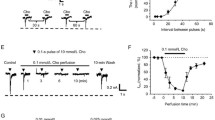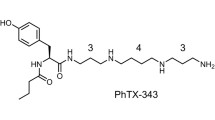Abstract
Giant neurons of the mollusc Lymnaea stagnalis contain heterogeneous population of nicotinic acetylcholine receptors (nAChRs) according to their relative sensitivity to antagonists. All these receptors are involved in the total response to acetylcholine (ACh). To evaluate activity of different pharmacological agents correctly it is necessary to know ionic selectivity of nAChRs which participate in transmembrane ionic current. In this work we studied the influence of ionic composition of the external and intracellular solutions on the current amplitude and current–voltage relation under the action of ACh or other nAChR agonists on the identified neurons of the left and right parietal ganglia of Lymnaea. After non-permeable cation N-methyl-D-glucamine was completely substituted for external Na+ ions there were no changes in the current characteristics. After a 10-fold decrease in Cl–concentration in the external solution there was a considerable shift of the current–voltage curve to the right, outward currents at the holding potential (Vh) up to 30 mV were not observed. On the contrary, a 10-fold decrease of Cl– concentration in the intracellular solution led to a shift of the current–voltage curve to hyperpolarizing direction, the reversal potential shift was in the average –42 mV. When ACh and nicotinic agonists with higher selectivity towards vertebrate α7 neuronal nAChR type and one of the two subtypes of Lymnaea nAChRs were compared, no differences in changes of ionic current characteristics were found. Neurons with distinct relative fraction of one or another nAChR subtype reacted to Cl– concentration change in the same way. Our results support earlier data on Cl– mechanism of Lymnaea neuron responses to ACh and evidence identical ionic selectivity of the two nAChR subtypes in identified neurons tested.
Similar content being viewed by others
Abbreviations
- ACh:
-
acetylcholine
- Chol:
-
choline
- [Cl]in and [Cl]o :
-
Cl–concentrations in the intracellular and external solutions, respectively
- Cyt:
-
cytisine
- ECl :
-
chloride equilibrium potential
- Er :
-
reversal potential
- ΔEr :
-
a shift of reversal potential
- ImI:
-
α-conotoxin ImI
- LP1,2,3 and RPV2,3:
-
identified giant neurons from the left and right (ventral side) parietal ganglia of L. stagnalis
- nAChR:
-
nicotinic acetylcholine receptor
- nAChR-Ls1:
-
Lymnaea nicotinic receptors with high sensitivity to ImI, relatively low sensitivity to ACh and fast desensitization to ACh
- nAChR-Ls2:
-
Lymnaea nicotinic receptors with low sensitivity to ImI, relatively high sensitivity to ACh, and slow desensitization to ACh
- NMDG:
-
N-methyl-D-glucamine
- V h :
-
holding potential
- Rin :
-
intracellular solution
- Ro :
-
external solution
References
Galzi J. L. Devillers-Thiery A., Hussy N., Bertrand S., Changeux J. P., Bertrand D. 1992. Mutations in the channel domain of a neuronal nicotinic receptor convert ion selectivity from cationic to anionic. Nature, 359, 500–505.
Karlin A. 2002. Emerging structure of the nicotinic acetylcholine receptors. Nat. Rev. Neurosci. 3, 102–114.
Jensen M. L., Schousboe A., Ahring P. K. 2005. Charge selectivity of the Cys-loop family of ligand-gated ion channels. J. Neurochem. 92, 217–225.
Dani J. A., Bertrand D. 2007. Nicotinic acetylcholine receptors and nicotinic cholinergic mechanisms of the central nervous system. Annu. Rev. Pharmacol. Toxicol. 47, 699–729.
Kehoe J. S. 1972. Ionic mechanisms of a two-component cholinergic inhibition in Aplysia neurones. J. Physiol. (London) 225, 85–114.
Ger B. A., Zeimal E. V. 1976. Two kinds of cholinoreceptors on the membrane of the completely isolated identified Planorbarius corneus neurone. Nature, 259, 681–684.
Ikemoto Y., Ishizuka S., Ono K., Akaike N. 1988. Kinetic analysis of acetylcholine-induced chloride current in isolated snail neurons. Cell. Mol. Neurobiol. 8, 293–305.
Kehoe JS., MacIntosh J. M. 1998. Two distinct nicotinic receptors, one pharmacologically similar to the vertebrate α7-containing receptor, mediate Cl currents in Aplysia neurons. J. Neurosci. 18, 8198–8213.
Jones A. K., Sattelle D. B. 2003. Functional genomics of the nicotinic acetylcholine receptor gene family of the nematode Caenorhabditis elegans. BioEssays. 26, 39–49.
Putrenko I., Zakikhani M., Dent J. A. 2005. A family of acetylcholine-gated chloride channel subunits in Caenorhabditis elegans. J. Biol. Chem. 280, 6392–6398.
Kislov A. N., Kazachenko V. N. 1974. Ionic currents of activated cholinoreceptive membrane of isolated Lymnaea neurons. In: Biophysics of living cells. Frank G. M. Ed., Pushchino, no. 4, part 2, pp. 39–44.
Chemeris N. K., Kazachenko V. N., Kislov A. N., Kurchikov A. L. 1981. Inhibition of acetylcholine responses by intracellular calcium in Lymnaea stagnalis neurons. J. Physiol. (London) 323, 1–19.
van Nierop P., Keramidas A., Bertrand S., van Minnen J., Gouwenberg Y., Bertrand D., Smit A. B. 2005. Identification of molluscan nicotinic receptor (nAChR) subunits involved in formation of cation-and anion-selective nAChRs. J. Neurosci. 25, 10617–10626.
van Nierop P., Bertrand S., Munno D. W., Gouwenberg Y., van Minnen J., Spafford J. D., Syed N. I., Bertrand D., Smit A. B. 2006. Identification and functional expression of a family of nicotinic acetylcholine receptor subunits in the central nervous system of the mollusc Lymnaea stagnalis. J. Biol. Chem. 281, 1680–1691.
Vulfius C. A., Krasts I. V., Utkin Yu. N., Tsetlin V. I. 2001. Nicotinic receptors in Lymnaea stagnalis neurons are blocked by neurotoxins from cobra venoms. Neurosci. Lett. 309, 189–192.
Vulfius C. A., Tumina O. B., Kasheverov I. E., Utkin Yu. N., Tsetlin V. I. 2005. Diversity of nicotinic receptors mediating Cl–current in Lymnaea neurons distinguished with specific agonists and antagonist. Neurosci. Lett. 373, 232–236.
Vulfius C. A., Kasheverov I. E., Starkov V. G., Osipov A. V., Andreeva T. V., Filkin S. Yu., Gorbacheva E. V., Astashev M. E., Tsetlin V. I., Utkin Yu. N. 2014. Inhibition of nicotinic acetylcholine receptors, a novel facet in the pleiotropic activities of snake venom phospholipases A2. PLoS One. doi 10. 1371/journal. pone. 0115428
Benjamin P. R., Ings C. T. 1972. Golgi–Cox studies on the central nervous system of a gastropod mollusc. Z. Zellforsch. 128, 564–582.
Kostyuk P. G., Kryshtal O. A., Pidoplichko V. I. 1981. Intracellular perfusion. J. Neurosci. Meth. 4, 201–210.
Kazachenko V. N., Kislov A. N., Veprintsev B. N. 1979. Cholinoreceptive membrane inactivation by the depolarization of Lymnaea stagnalis neurons. Comp. Biochem. Physiol. 63C, 61–66.
Séguéla P., Wadiche J., Dineley-Miller K., Dani J. A., Patrick J. W. 1993. Molecular cloning, functional properties, and distribution of rat brain α7: A nicotinic cationic channel highly permeable to calcium. J. Neurosci. 13, 596–604.
Castro N. G., Albuquerque E. X. 1995. The α-bungarotoxin-sensitive hippocampal nicotinic acetylcholine receptor has a high calcium permeability. Biophys. J. 68, 516–524.
Author information
Authors and Affiliations
Corresponding author
Additional information
Original Russian Text © E.V. Gorbacheva, V.S. Ershova, M.E. Astashev, C.A. Vulfius, 2018, published in Biologicheskie Membrany, 2018, Vol. 35, No. 4, pp. 289–296.
Rights and permissions
About this article
Cite this article
Gorbacheva, E.V., Ershova, V.S., Astashev, M.E. et al. Two Subtypes of Nicotinic Acetylcholine Receptors in Lymnaea stagnalis Neurons Control Chloride Conductance. Biochem. Moscow Suppl. Ser. A 12, 261–267 (2018). https://doi.org/10.1134/S1990747818030042
Received:
Accepted:
Published:
Issue Date:
DOI: https://doi.org/10.1134/S1990747818030042




